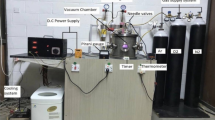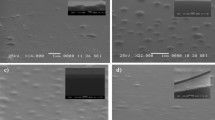Abstract
The titanium nitride (TiNx) thin film with a controllable surface structure was fabricated by the dc-reactive magnetron sputtering technique, and the variation of microstructure in the surface layer with the energy of condensed adatom was investigated through X-ray diffraction (XRD) pattern and transmission electron microscope (TEM). It was found that the lattice parameters and the full width at half maximum (fwhm) of XRD peak on the top layers in the preferred orientation of (111) and (002) were closely correlated to the impacting induced phase composition, compressive strain, crystallite size and the fault density of the thin films. In the theory, a new means was used to model the atomistic process of per condensed adatom. The average energy at least in the minimum energy state of the incorporate adatom on TiN surface layer was statistically formulized through a careful consideration of dynamical process, which properly interpreted the experimental observations.
Similar content being viewed by others
References
Dimitriadis, C. A., Lee, J. I., Patsalas, P. et al., Characteristics of TiNx/n-Si Schottky diodes deposited by reactive magnetron sputtering, J. Appl. Phys., 1999, 85(8): 4238–4242.
Dimitriadis, C. A., Logothetidis, S., Alexandrou, I., Schottky barrier contacts of titanium nitride on n-type silicon, Appl. Phys. Lett., 1995, 66(4): 502–504.
Logothetidis, S., Alexandrou, I., Paradopoulos, A.,In situ spectroscopic ellipsometry to monitor the process of TiNx thin films deposited by reactive sputtering, J. Appl. Phys., 1995, 77(3): 1043–1047.
Petrov, I., Hultman, L., Sundgren, J. E. et al., Polycrystalline TiN films deposited by reactive bias magnetron sputtering: Effects of ion bombardment on resputtering rates, film composition, and microstructure, J. Vac. Sci. Technol., 1992, A10(2): 265–272.
Petrov, I., Myers, A. M., Greene, J. E. et al., Mass and energy resolved detection of ions and neutral sputtered species incident at the substrate during reactive magnetron sputtering of Ti in mixed Ar+N2 mixtures, J. Vac. Sci. Technol., 1994, A12(5): 2846–2854.
Hultman, L., Sundgren, J. E., Greene, J. E. et al., High-flux low-energy (=20 eV) N2 + ion irradiation during TiN deposition by reactive magnetron sputtering: Effects on microstructure and preferred orientation, J. Appl. Phys., 1995, 78(9): 5395–5403.
Abidi, F., Petrov, I., Greene, J. E. et al., Effects of high-flux low-energy (20–100 eV) ion irradiation during deposition on the microstructure and preferred orientation of Ti0.5Al0.5N alloys grown by altra-high-vacuum reactive magnetron sputtering, J. Appl. Phys., 1993, 73(12): 8580–8589.
Je, J. H., Noh, D. Y., Kim, H. K. et al., Preferred orientation of TiN films studied by a real time synchrotron X-ray scattering. J. Appl. Phys., 1997, 81(9): 6126–6133.
Je, J. H., Noh, D. Y., Kim, H. K. et al., The crossover of preferred orientation in TiN film growth: A real time X-ray scattering study, J. Mater. Res., 1997, 12(1): 9–12.
Schell, N., Matz, W., Bottiger, J. et al., Development of texture in TiN films by use ofin situ synchrotron X-ray scattering, J. Appl. Phys., 2002, 91(4): 2037–2044.
Ziegler, J. F., Biersack, J. P., Littmark, U., The Stopping and Range of Ions in Solids, New York: Pergamon Press, 1985.
Ma, Z. Q., Kido, K., The atomic displacements on surface generated by low-energy projectile, Thin Solid Films, 2000, 359(2): 288–292.
Patsalas, P., Charitidis, C., Logothetidis, S., The effect of substrate temperature and biasing on the mechanical properties and structure of sputtered titanium nitride thin films, Surf. Coat. Technol., 2000, 125(1–3): 335–340.
Patsalas, P., Logothetidis, S., Optical, electronic, and transport properties of nanocrystalline titanium nitride thin films, J. Appl. Phys., 2001, 90(9): 4725–4734.
Marlo, M., Milman, V., Densityfunctional study of bulk and surface properties of titanium nitride using different exchange-correlation functionals, Phys. Rev. B, 2000, 62(4): 2899–2907.
Author information
Authors and Affiliations
Corresponding author
About this article
Cite this article
Ma, Z., Zhang, Q. Microstructure controlling of Ti/N particles dissipated energy to superficial layer of titanium nitride film. Chin.Sci.Bull. 49, 230–234 (2004). https://doi.org/10.1007/BF03182803
Received:
Accepted:
Issue Date:
DOI: https://doi.org/10.1007/BF03182803




